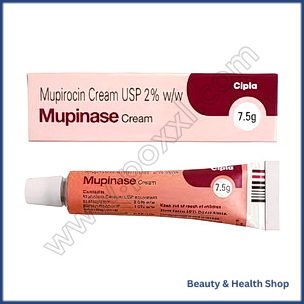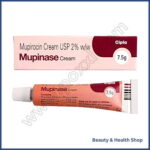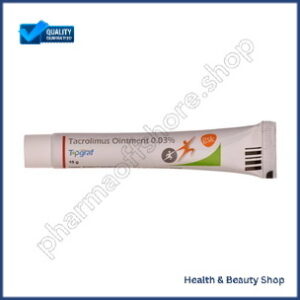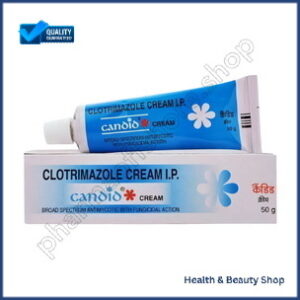ADDICTION
ALCOHOL DEPENDENCE
QUIT SMOKING
ALLERGY
ANTI FUNGAL
FUNGAL INFECTION
FUNGAL NAIL INFECTIONS
ANTI-REJECTION DRUGS
ANTI WORM
ANTIBIOTIC
BACTERIAL INFECTIONS
ARTHRITIS
GOUT
OSTEOARTHRITIS
RHEUMATOID ARTHRITIS
BLOOD
LOW PLATELET COUNT
THROMBOPHLEBITIS
VARICOSE VEINS
COLON
ANAL FISSURE
PILES
ULCERATIVE COLITIS
DIABETES CARE
DIABETES INSIPIDUS
DIABETES TYPE
DIABETIC FOOT ULCERS
GLUCOSE MONITOR
EYES/EAR CARE
DRY EYES
EYE CARE
EYE EXAMINATION
EYE INFECTION
EYE LASHES
EYE PAIN
GLAUCOMA
OCULAR HYPERTENSION
UVEITIS
FEVER CARE
MALARIA
RHEUMATIC FEVER
TYPHOID FEVER
GASTROINTESTINAL
ACIDITY
CONSTIPATION
CROHN'S DISEASE
DIARRHOEA
GALLBLADDER STONES
INTESTINAL ULCERS
IRRITABLE BOWEL SYNDROME
MOTION SICKNESS
NAUSEA
Mupinase Cream (Mupirocin)
| Active Ingredient (Generic Name): | Mupirocin |
|---|---|
| Indication: | used in the treatment of bacterial skin infections |
| Manufacturer: | Cipla Limited |
| Packaging: | 7.5 gm in one tube |
| Strength: | 7.5gm |
From: $31.00
Mupinase Cream, also referred to as Mupirocin, effectively treats bacterial skin infections by halting bacterial growth, assisting in healing, and preventing further spread. Apply a thin layer three times daily on clean, dry skin. Use clean hands and tools, avoiding contact with eyes, nose, or mouth. Cover wounds post-application. Check for drug interactions, report side effects promptly, and store at room temperature. Seek medical help for emergencies or overdose and inform your healthcare provider of all medications used. Following these guidelines guarantees excellent results. Additional details about this medication are available for further insights.
Begin by understanding the benefits of using Mupinase Cream for treating skin infections. Mupinase Cream, also known as Mupirocin, is a prescription antibiotic medication commonly used to treat bacterial skin infections. This cream works by stopping the growth of bacteria on the skin, helping to eliminate the infection and promote healing.
One of the key advantages of using Mupinase Cream is its effectiveness in treating a variety of skin conditions caused by bacteria, such as impetigo, folliculitis, and minor skin wounds. By applying the cream directly to the affected area, you can target the infection and reduce its spread. Additionally, Mupinase Cream is generally well-tolerated and has a low risk of causing serious side effects when used as directed by your healthcare provider.
Why is this medication prescribed?
When your healthcare provider prescribes Mupinase Cream, it is typically to treat bacterial skin infections effectively by stopping bacterial growth on the skin. Mupirocin, the active ingredient in Mupinase Cream, works by inhibiting the synthesis of bacterial proteins essential for their survival. This medication is commonly used to address conditions like impetigo, a contagious skin infection causing red sores, and folliculitis, an inflammation of the hair follicles often resulting in pus-filled bumps. Additionally, Mupinase Cream can be prescribed for treating minor skin wounds susceptible to bacterial infections. By targeting the specific bacteria causing the infection, Mupinase Cream helps to alleviate symptoms and promote healing. It is important to use this medication as directed by your healthcare provider to guarantee its effectiveness and prevent the development of antibiotic resistance. If you have any concerns or experience adverse reactions while using Mupinase Cream, consult your healthcare provider promptly for further guidance.
How should this medicine be used?
To use Mupinase Cream effectively, apply a thin layer to the affected skin area three times daily. Before application, make sure the skin is clean and dry. Wash your hands before and after applying the cream to prevent the spread of infection. Use a sterile gauze pad or cotton swab to apply the cream, avoiding contact with eyes, nose, mouth, or any open wounds. Gently massage the cream into the skin until fully absorbed. If you are treating a wound, cover it with a sterile bandage after applying the cream. Continue using Mupinase Cream for the full prescribed length of time, even if symptoms improve before completion. Do not use more or less of the medication than prescribed, and do not use it more frequently than directed by your healthcare provider. If you have any questions about the application or usage of Mupinase Cream, consult your doctor or pharmacist for clarification and guidance.
Other uses for this medicine
Considering Mupinase Cream‘s effectiveness, healthcare providers may recommend alternative uses beyond its primary intended purpose. While Mupinase Cream is primarily utilized for treating bacterial skin infections, it may also be prescribed for other conditions. One common alternative use is for preventing infections in minor cuts, scrapes, or burns. The cream can help establish a barrier against harmful bacteria, reducing the risk of infection and promoting faster healing.
In addition to skin infections, Mupinase Cream may be recommended for treating impetigo, a highly contagious bacterial skin infection that primarily affects children. By applying the cream to the affected areas, the spread of bacteria can be controlled, aiding in the resolution of the infection.
Furthermore, healthcare providers may suggest the use of Mupinase Cream for certain types of nasal infections caused by bacteria. By applying a small amount inside the nostrils, the cream can help eradicate the bacteria, reducing symptoms and promoting recovery. It is essential to follow your healthcare provider’s instructions carefully when using Mupinase Cream for these alternative purposes to guarantee safe and effective treatment.
What special precautions should I follow?
Before using Mupinase Cream, it is important to check for any possible drug interactions. Make sure to inform your healthcare provider about any medications, supplements, or herbal products you are currently using. This precaution can help avoid any adverse effects and guarantee the effectiveness of the treatment.
Check for Drug Interactions
Checking for potential drug interactions is crucial when using Mupinase Cream (Mupirocin). To guarantee your safety and the effectiveness of the medication, consider the following precautions:
- Consult Your Healthcare Provider: Before starting Mupinase Cream, inform your healthcare provider about all the medications, supplements, and herbal products you are currently using.
- Be Aware of Allergies: Inform your doctor if you have any known allergies to medications, especially antibiotics or topical creams.
- Avoid Harmful Combinations: Certain medications, such as other topical antibiotics or antiseptics, may interact negatively with Mupinase Cream. Stay vigilant.
- Monitor for Side Effects: Keep an eye out for any unusual symptoms or reactions after starting Mupinase Cream and report them promptly to your healthcare provider.
What special dietary instructions should I follow?
To maintain the effectiveness of Mupinase Cream (Mupirocin), it is important to adhere to any specific dietary guidelines recommended by your healthcare provider. While using Mupinase Cream, there are typically no specific dietary restrictions that need to be followed. However, it is always a good idea to maintain a balanced and healthy diet to support your overall health and immune system, which can aid in the healing process of any skin infections the cream is being used to treat.
Ensure you are consuming a variety of fruits, vegetables, whole grains, lean proteins, and staying hydrated by drinking an essential amount of water daily. If you have any specific dietary concerns or conditions that may interact with the medication, it is vital to discuss this with your healthcare provider. They can offer personalized advice based on your individual health needs. Overall, maintaining a healthy lifestyle through good nutrition can complement the benefits of Mupinase Cream and support your body’s ability to fight infections effectively.
What should I do if I forget a dose?
If you forget a dose of Mupinase Cream (Mupirocin), promptly apply it as soon as you remember. It is important to maintain a consistent application schedule to guarantee the effectiveness of the medication. If it is almost time for your next scheduled dose, skip the missed application and continue with your regular dosing schedule. Do not double up on doses to make up for the missed one, as this can increase the risk of side effects without providing additional benefits.
Consistency in applying Mupinase Cream is vital for the successful treatment of skin infections. Set a reminder or establish a routine to help you remember your dosing times. If you frequently forget doses, consider using alarms or other methods to stay on track with your medication schedule. If you have any concerns or questions about missed doses or how to best manage your treatment plan, consult your healthcare provider for personalized advice and guidance.
What side effects can this medication cause?
Mupinase Cream, or Mupirocin, may cause side effects that necessitate immediate medical attention. Some side effects can be severe, so if you experience persistent symptoms like redness, swelling, or intense itching, it is crucial to contact your doctor promptly. Being aware of these potential side effects can help you take the required steps to guarantee your well-being while using this medication.
Persistent Side Effects Alert
Experiencing persistent side effects from Mupinase Cream, also known as Mupirocin, may require immediate medical attention. Here are some side effects that could indicate a more serious issue:
- Severe skin irritation, including redness, swelling, or blistering.
- Prolonged itching or burning sensation at the application site.
- Worsening of the original skin condition or the development of a new rash.
- Persistent pain or discomfort that does not improve with time.
If you notice any of these symptoms, it is essential to seek medical help promptly. Your healthcare provider can assess the situation and determine the appropriate course of action to safeguard your well-being.
Some side effects can be serious. If you experience any of the following symptoms, call your doctor immediately:
When encountering certain side effects from Mupinase Cream, immediate medical attention may be necessary, particularly if you observe the following symptoms:
- Severe Skin Irritation: If you experience intense redness, swelling, or a rash that worsens over time.
- Allergic Reactions: Symptoms like itching, hives, difficulty breathing, or swelling of the face, lips, tongue, or throat.
- Unusual Changes: Any unexpected symptoms such as severe itching, burning, or stinging at the application site.
- Signs of Infection: If you notice increased pain, warmth, swelling, or oozing of pus from the treated area.
If any of these symptoms occur, it is essential to contact your healthcare provider promptly for further evaluation and guidance.
What should I know about the storage and disposal of this medication?
Ensure proper storage and disposal of this medication to maintain its effectiveness and prevent any potential harm. Store Mupinase cream at room temperature away from moisture and heat. Keep the tube tightly closed when not in use. Avoid freezing the medication. Make sure that it is out of reach of children and pets to prevent accidental ingestion. Do not store Mupinase cream in the bathroom or near the kitchen sink where it might be exposed to moisture.
When it comes to disposal, follow specific guidelines provided by your healthcare provider or pharmacist. Do not flush Mupinase cream down the toilet unless instructed to do so. Properly discard any expired or unused medication. You can consult your pharmacist for the correct disposal method in your area. It is essential to dispose of medications responsibly to prevent environmental contamination and accidental ingestion by others. If you have any questions regarding the storage or disposal of Mupinase cream, do not hesitate to seek advice from a healthcare professional.
In case of an emergency/overdose
In the event of an emergency or overdose involving Mupinase cream, promptly seek medical assistance. If you accidentally ingest Mupinase cream or experience any severe reactions such as difficulty breathing, swelling of the face, lips, or throat, or severe skin irritation, contact emergency services immediately. It’s crucial to provide healthcare professionals with information about the cream and the amount used to help them provide appropriate treatment.
When seeking medical help, bring the Mupinase cream packaging or container with you to show the healthcare provider. This will assist them in identifying the medication and its ingredients quickly. Do not attempt to induce vomiting unless directed by a healthcare professional. In cases of overdose, the healthcare provider will determine the best course of action based on the symptoms and the amount of Mupinase cream ingested.
What other information should I know?
Make sure to inform your healthcare provider about any other medications or skin products you are using before using Mupinase cream. This is essential to avoid any potential interactions or adverse effects that could arise from combining different substances. Your healthcare provider will be able to assess the safety of using Mupinase cream alongside your current medications or skincare products and provide you with personalized advice.
Additionally, it is vital to follow the instructions provided by your healthcare provider or the product label when applying Mupinase cream. Use the prescribed amount and apply it only to the affected area as directed. Avoid using larger amounts or applying it more frequently than recommended, as this can lead to unintended side effects or decreased effectiveness of the medication.
If you experience any unexpected or concerning symptoms after using Mupinase cream, such as irritation, redness, or itching, contact your healthcare provider for further guidance. It is important to address any unusual reactions promptly to ensure your safety and well-being.
Brand names
When considering brand names for Mupinase cream, look for the specific name that the medication is marketed under in your region. Here is a table showing some common brand names of Mupirocin cream in different countries:
| Country | Brand Name |
|---|---|
| United States | Bactroban |
| United Kingdom | Bactroban |
| Australia | Bactroban |
In the United States, Mupinase cream is often known as Bactroban. Similarly, in the United Kingdom and Australia, it is also commonly referred to as Bactroban. These brand names may vary in other regions, so it is essential to check the specific brand name used in your area. Familiarizing yourself with the brand name of Mupinase cream in your region will help make sure you are purchasing the correct medication prescribed for your needs.
Purchase Locations for Mupinase Cream
You can easily find Mupinase Cream available for purchase at various pharmacies and online retailers specializing in healthcare products. Pharmacies such as CVS, Walgreens, and Rite Aid commonly stock this medication both in-store and online. These establishments often have knowledgeable pharmacists who can assist you with any questions you may have regarding Mupinase Cream.
If you prefer the convenience of online shopping, reputable websites like Amazon, HealthWarehouse, and Healthline Pharmacy also offer Mupinase Cream for purchase. When buying online, make sure to verify the authenticity of the website to make certain you are getting a legitimate product.
Additionally, some healthcare providers may sell Mupinase Cream directly to their patients. If you have a prescription for this medication, inquire with your healthcare provider if they offer it for purchase in their office.
To summarise
After identifying various purchase locations for Mupinase Cream, now let’s summarize the key points for your convenience. Mupinase Cream, containing the active ingredient Mupirocin, is primarily used to treat bacterial skin infections. It works by inhibiting the growth of bacteria on the skin, aiding in the healing process. When applying Mupinase Cream, make sure the affected area is clean and dry before gently applying a thin layer of the cream. Avoid covering the area with bandages unless directed by a healthcare professional. Common side effects may include itching, burning, or stinging at the application site. If these side effects persist or worsen, consult your doctor promptly. It is important to complete the full course of treatment as prescribed by your healthcare provider, even if symptoms improve before the treatment is finished. In case of any severe reactions or signs of an allergic reaction such as rash, swelling, or difficulty breathing, seek immediate medical assistance. Remember to store Mupinase Cream at room temperature away from moisture and heat.








There are no reviews yet.